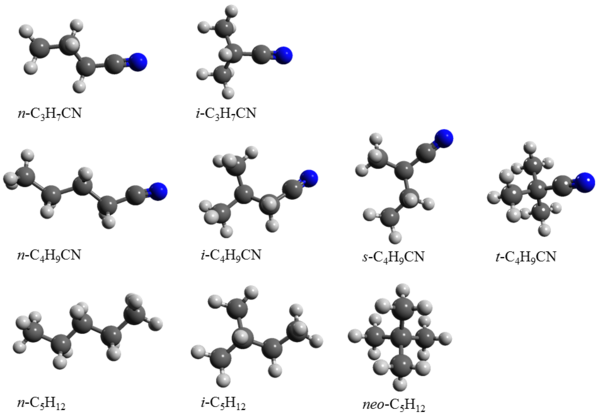The Garrod group specializes in chemical simulations of star-forming regions, using coupled gas-phase and dust grain-surface kinetics models. Our group uses a three-phase chemical model called MAGICKAL (Model for Astrophysical Gas and Ice Chemical Kinetics And Layering), which can distinguish between the surface layer and the bulk phase of the ice that forms on microscopic dust grain surfaces. We have developed some of the most advanced chemical networks in use to simulate the production of highly complex interstellar organic molecules.
A recent publication investigated the production of branched carbon-chain molecules, such as iso-propyl cyanide (Garrod et al. 2017). The latter molecule (shown in image, below) was detected for the first time in interstellar space (Belloche et al. 2014) toward the Galactic Center high-mass star-forming region Sagittarius B2(N). The detection was made as a result of the EMoCA (Exploring Molecular Complexity with ALMA) survey, which is an unbiased molecular line survey of Sgr B2(N) in ALMA band 3 (~3mm). This was the first time a branched aliphatic molecule had been detected anywhere in the interstellar medium. The branched iso-propyl cyanide (i-C3H7CN) was found to be highly abundant with respect to its straight-chain isomer, normal-propyl cyanide (n-C3H7CN), with a ratio i:n = 0.40.

Garrod et al. (2017) developed a new chemical network to simulate the interstellar production of both forms of propyl cyanide, as well as all four isomers of the larger homolog, butyl cyanide (shown above), three of which have a branched-chain structure. Our models predict that for butyl cyanide, the branched structure sec-butyl cyanide should dominate over the other forms, including the straight-chain normal-butyl cyanide (see below). We hope to test this prediction observationally with new ALMA data for Sgr B2(N).

